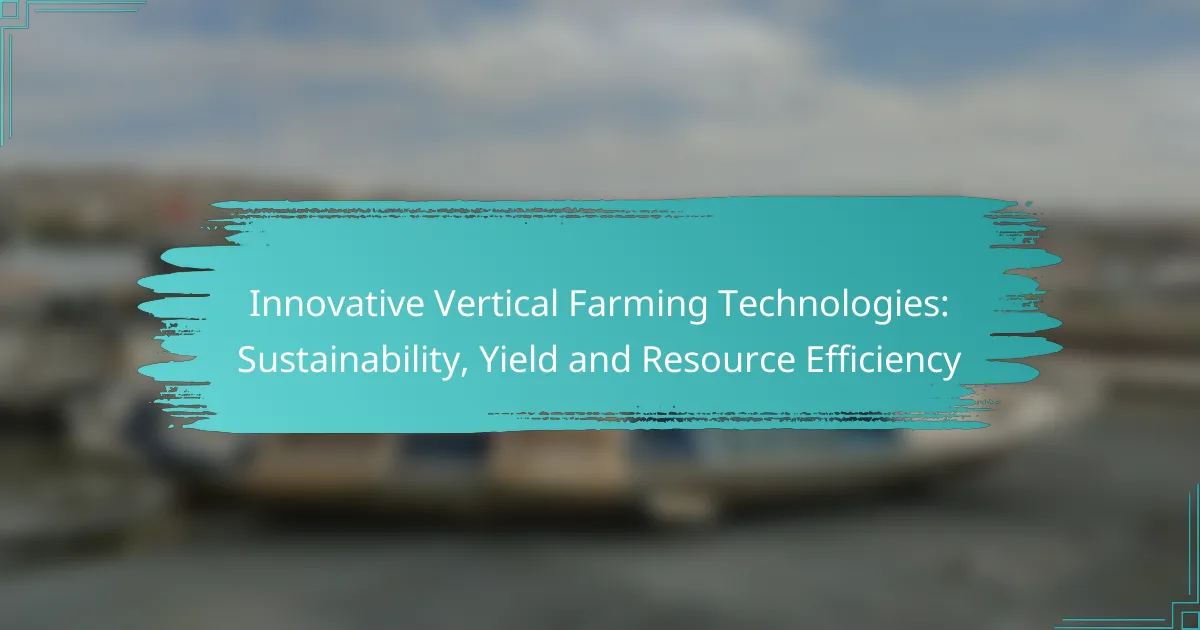Innovative vertical farming technologies are revolutionizing agriculture by maximizing crop yield while minimizing resource consumption, particularly in terms of water and space. Utilizing methods such as hydroponics, aeroponics, and automated climate control, these systems enhance sustainability and significantly reduce environmental impact, making them a promising solution for future food security.
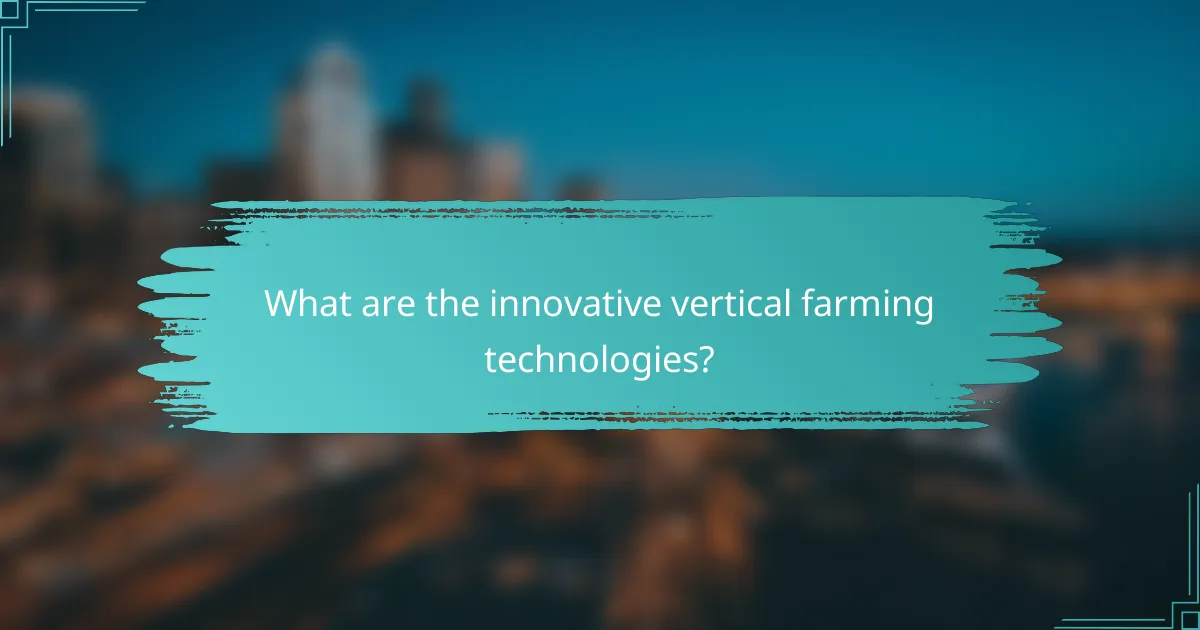
What are the innovative vertical farming technologies?
Innovative vertical farming technologies encompass advanced methods that maximize crop yield while minimizing resource use, particularly water and space. These technologies include hydroponics, aeroponics, vertical aeroponic towers, LED grow lights, and automated climate control systems, all designed to enhance sustainability in agriculture.
Hydroponics systems
Hydroponics systems grow plants in a nutrient-rich water solution instead of soil, allowing for faster growth and higher yields. This method can reduce water usage by up to 90% compared to traditional farming, making it an efficient choice for urban environments.
Key considerations include the type of nutrient solution used and the system’s design, such as deep water culture or nutrient film technique. Regular monitoring of pH and nutrient levels is essential to ensure optimal plant health.
Aeroponics systems
Aeroponics systems suspend plants in air and mist their roots with a nutrient solution, promoting rapid growth and efficient resource use. This method can achieve growth rates significantly faster than soil-based farming.
When implementing aeroponics, it’s crucial to maintain proper humidity and misting intervals to prevent root dehydration. This system is particularly suitable for leafy greens and herbs, which thrive in such environments.
Vertical aeroponic towers
Vertical aeroponic towers are compact structures that utilize aeroponics to grow plants vertically, maximizing space efficiency. These towers can be integrated into urban settings, allowing for food production in limited areas.
Considerations for vertical towers include the selection of appropriate crops and ensuring adequate light exposure. Regular maintenance is necessary to keep the misting system functioning properly and to prevent any blockages.
LED grow lights
LED grow lights provide the specific light spectrum needed for photosynthesis, enabling year-round crop production indoors. They are energy-efficient and can significantly reduce electricity costs compared to traditional lighting systems.
When choosing LED lights, consider the light intensity and spectrum required for different plant types. Positioning the lights at the correct distance from the plants is crucial to avoid light burn or insufficient light exposure.
Automated climate control systems
Automated climate control systems regulate temperature, humidity, and CO2 levels in vertical farms, creating optimal growing conditions. These systems can enhance crop quality and yield by responding in real-time to environmental changes.
Investing in a robust climate control system is essential for maintaining consistent conditions, especially in regions with extreme weather. Regular calibration and monitoring are necessary to ensure the system operates effectively and efficiently.
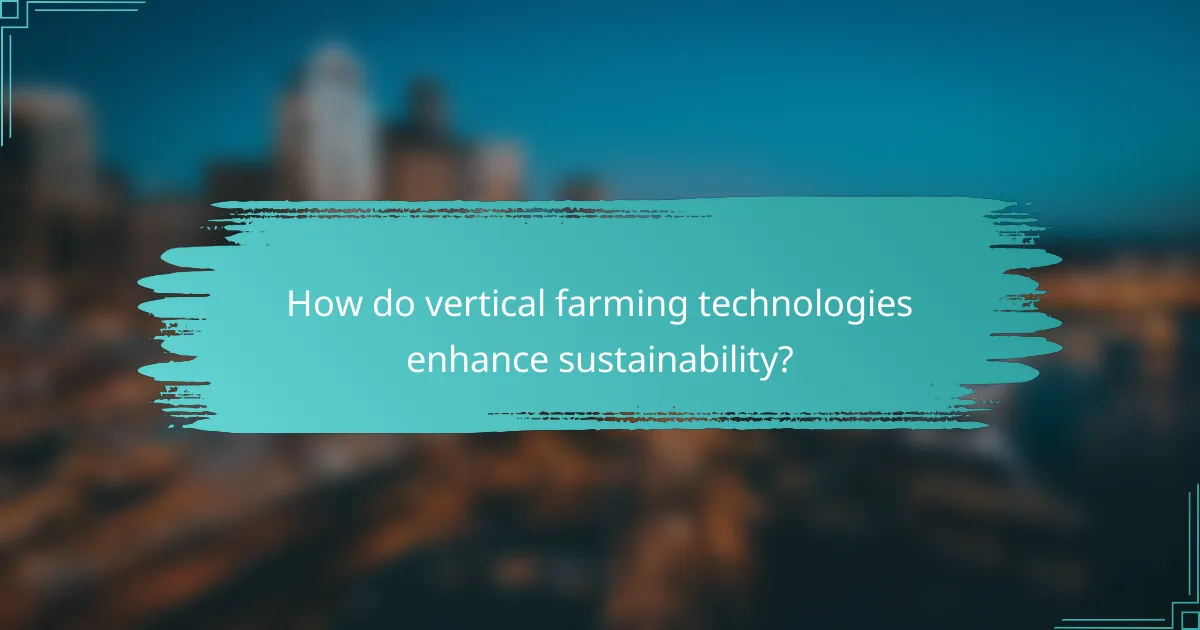
How do vertical farming technologies enhance sustainability?
Vertical farming technologies significantly enhance sustainability by optimizing resource use and reducing environmental impact. These systems leverage controlled environments to grow crops with minimal waste, ensuring efficient use of water, land, and energy.
Reduced water usage
Vertical farms utilize advanced irrigation techniques, such as hydroponics and aeroponics, which can reduce water usage by up to 90% compared to traditional farming. These methods recycle water within the system, minimizing runoff and evaporation.
For instance, a vertical farm can use as little as 1 liter of water to grow a head of lettuce, while conventional soil-based agriculture may require several liters. This efficiency is crucial in regions facing water scarcity.
Minimized land footprint
Vertical farming allows for high-density crop production in urban areas, significantly reducing the land footprint required for agriculture. By stacking layers of crops, these farms can produce food in a fraction of the space needed for traditional farming.
For example, a vertical farm can yield the same amount of produce as several acres of farmland, making it ideal for cities where arable land is limited. This approach not only conserves land but also reduces the need for transportation, as food can be grown closer to consumers.
Lower carbon emissions
By operating in urban settings and utilizing renewable energy sources, vertical farms can significantly lower carbon emissions associated with food production and transportation. The reduced need for pesticides and fertilizers also contributes to a smaller carbon footprint.
Additionally, vertical farms can integrate energy-efficient technologies, such as LED lighting and smart climate control systems, further decreasing their environmental impact. This shift towards sustainable practices aligns with global efforts to combat climate change and promote greener food systems.
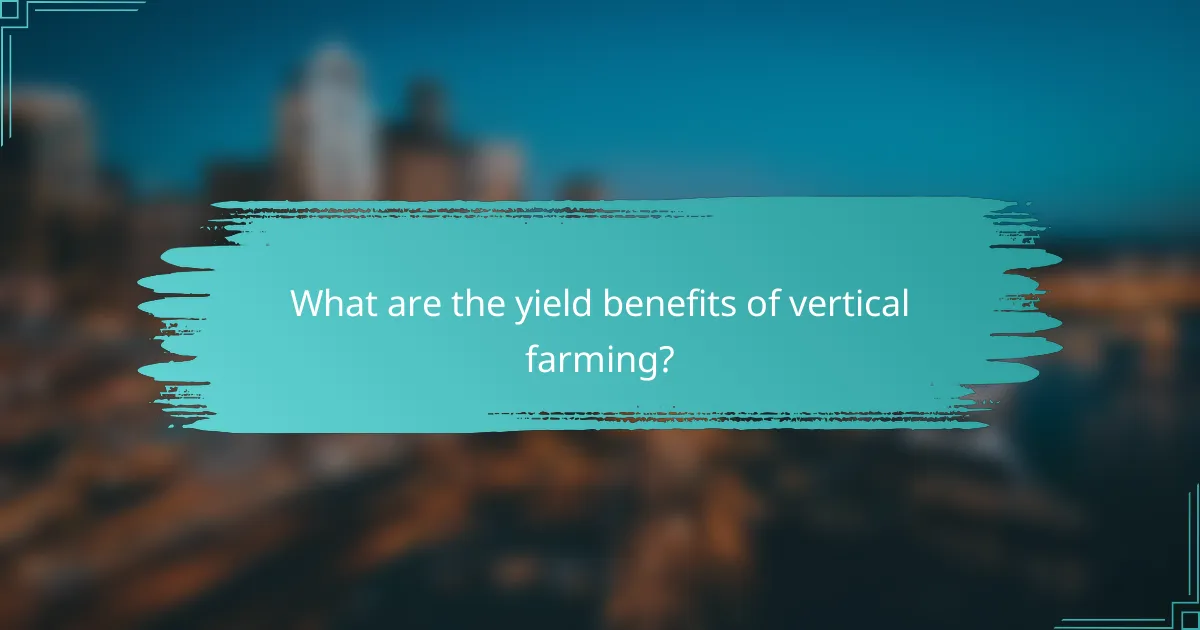
What are the yield benefits of vertical farming?
Vertical farming offers significant yield benefits by maximizing space and optimizing growing conditions. This innovative approach allows for higher production rates compared to traditional farming methods, making it a promising solution for food security.
Higher crop density
Vertical farming enables higher crop density by utilizing stacked layers and controlled environments. This means growers can produce more crops per square meter than in conventional fields, often increasing yields by several times. For instance, leafy greens can be grown in layers, allowing for a more efficient use of space and resources.
However, it’s essential to consider the specific crop types and their growth requirements. Some plants may thrive better in vertical systems than others, so selecting the right species is crucial for maximizing density and yield.
Year-round production
One of the key advantages of vertical farming is the ability to produce crops year-round, regardless of external weather conditions. This constant production cycle helps stabilize supply and meet consumer demand consistently. For example, crops like herbs and microgreens can be harvested multiple times a year, ensuring fresh produce is always available.
To achieve year-round production, growers must invest in climate control technologies, such as LED lighting and automated irrigation systems. While this may increase initial costs, the long-term benefits often outweigh the investment by providing a steady income stream.
Faster growth cycles
Vertical farming can significantly shorten growth cycles due to optimized environmental conditions, including light, temperature, and humidity. Many crops can grow faster in these controlled settings, often reducing the time from seed to harvest by weeks. For instance, some leafy greens can be ready for harvest in as little as three weeks.
Growers should monitor growth conditions closely to maximize these benefits. Adjusting factors like nutrient delivery and light exposure can further enhance growth rates, leading to quicker harvests and increased overall productivity.
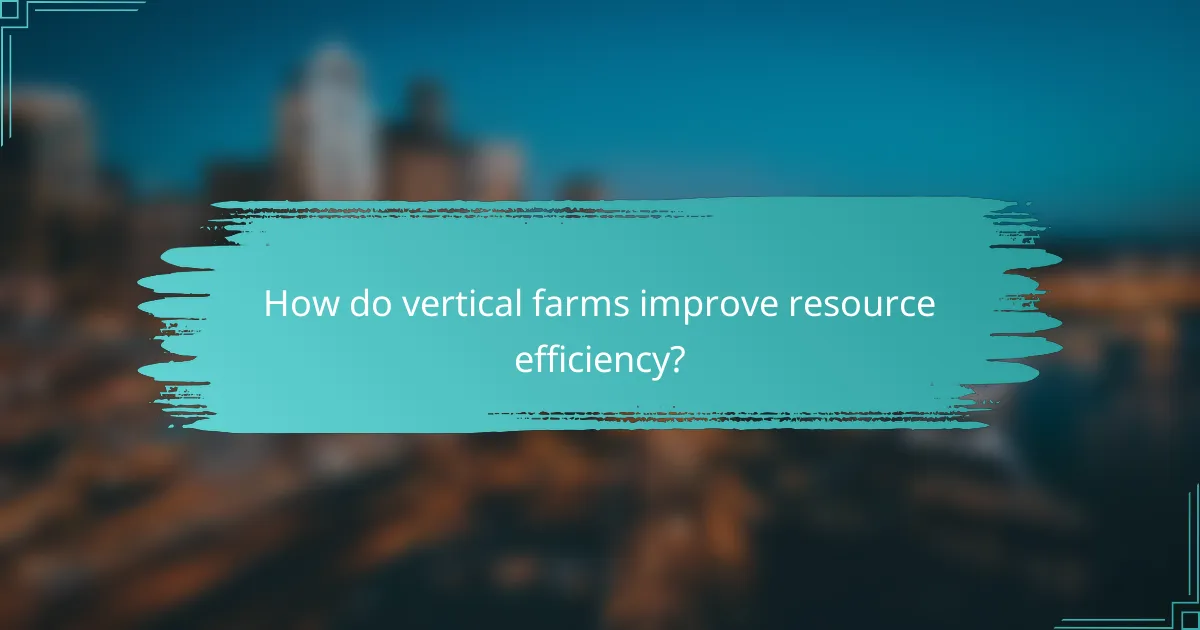
How do vertical farms improve resource efficiency?
Vertical farms enhance resource efficiency by utilizing advanced technologies to minimize waste and optimize inputs like water and nutrients. These systems are designed to produce high yields while significantly reducing the environmental impact associated with traditional farming methods.
Optimized nutrient delivery
Vertical farms employ hydroponic and aeroponic systems to deliver nutrients directly to plant roots, ensuring they receive exactly what they need for optimal growth. This method reduces nutrient runoff and minimizes the use of fertilizers, leading to a more sustainable approach to agriculture.
For instance, nutrient solutions can be precisely tailored to different plant species, allowing for efficient growth cycles. This targeted delivery can reduce nutrient use by up to 90% compared to conventional soil farming.
Energy-efficient systems
Energy efficiency in vertical farms is achieved through the use of LED lighting, which consumes significantly less electricity than traditional grow lights. These systems can be programmed to provide the optimal light spectrum for plant growth, further reducing energy consumption.
Additionally, many vertical farms incorporate renewable energy sources, such as solar panels, to power their operations. This combination of technologies can lead to energy savings of 30% or more compared to conventional farming practices.
Waste recycling methods
Vertical farms often implement waste recycling techniques to minimize environmental impact. Organic waste from plants can be composted or converted into bioenergy, creating a closed-loop system that reduces landfill contributions.
Furthermore, water used in hydroponic systems can be recirculated, significantly lowering overall water usage. This practice can cut water consumption by up to 95% compared to traditional farming, making vertical farms a more sustainable option.
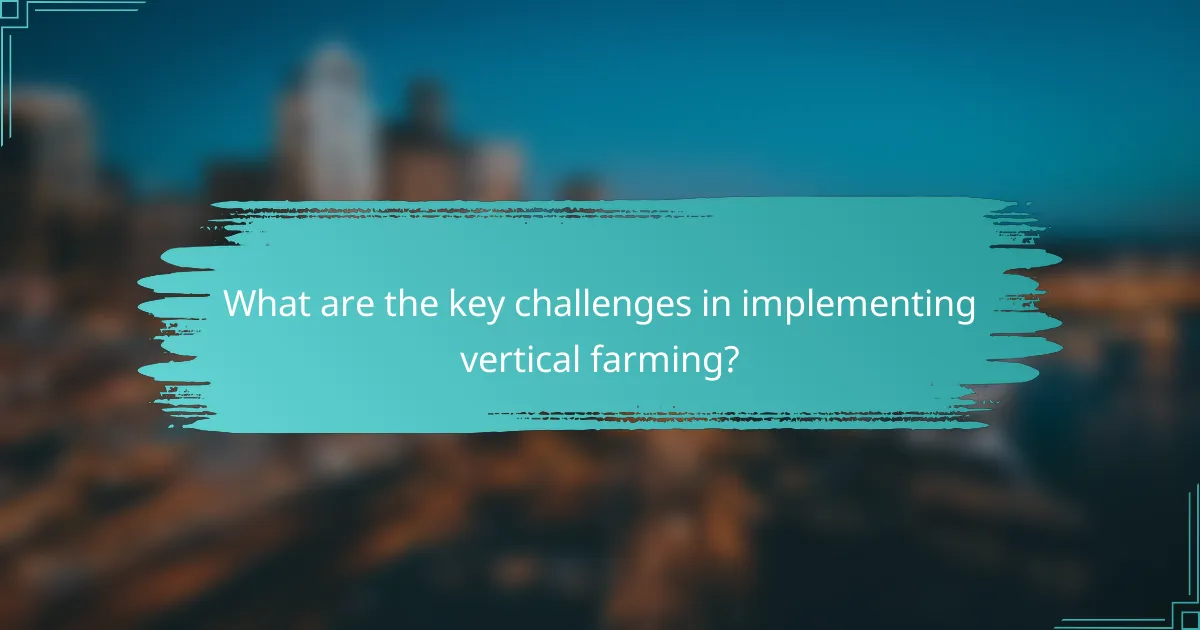
What are the key challenges in implementing vertical farming?
Implementing vertical farming involves several key challenges that can impact its success, including high initial investments, the need for technical expertise, and market acceptance issues. Addressing these challenges is crucial for the sustainable growth of vertical farming systems.
High initial investment
The initial investment for vertical farming can be significant, often ranging from hundreds of thousands to millions of dollars, depending on the scale and technology used. Costs include infrastructure, equipment, and technology such as LED lighting and climate control systems.
To mitigate financial risks, potential farmers should conduct thorough market research and feasibility studies. Exploring funding options, such as grants or partnerships, can also help alleviate some of the financial burden.
Technical expertise requirements
Vertical farming requires specialized knowledge in areas such as hydroponics, aeroponics, and environmental control systems. This expertise is essential for optimizing plant growth and ensuring efficient resource use.
Investing in training for staff or collaborating with experts can enhance operational efficiency. Additionally, leveraging technology for monitoring and automation can reduce the reliance on extensive technical knowledge.
Market acceptance issues
Market acceptance of vertically farmed produce can be a challenge, as consumers may be unfamiliar with the concept or skeptical about its quality compared to traditional farming. Building consumer trust is essential for market penetration.
Engaging in community outreach, offering tastings, and highlighting the sustainability benefits of vertical farming can help improve acceptance. Establishing partnerships with local retailers can also facilitate access to consumers and boost visibility.
